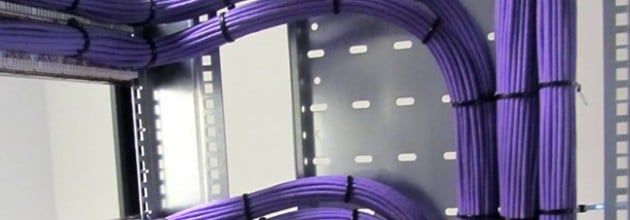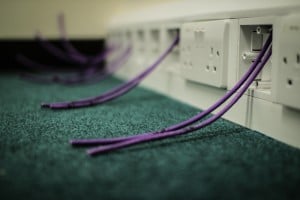Office network cabling: types and its uses for businesses

Office network cabling is necessity for not only guaranteed ROI but also to achieve flawless connectivity among devices that are being connected within a network. There are several kinds of cabling being done around UAE and Middle East region that can help our worthy users to earn more from their network infrastructure and connected devices. Have a look on below types and benefits of office network cabling.
UTP office network cabling
 UTP cables are found in many Ethernet networks and telephone systems. For indoor telephone applications, UTP is often grouped into sets of 25 pairs according to a standard 25-pair color code originally developed by AT&T Corporation. A typical subset of these colors shows up in most UTP cables. This office network cabling is typically made with copper wires measured at 22 or 24 American Wire Gauge with the colored insulation typically made from an insulator such as polyethylene or FEP and the total package covered in apolyethylene jacket. For urban outdoor telephone cables containing hundreds or thousands of pairs, this office network cabling is divided into smaller but identical bundles. Each bundle consists of twisted pairs that have different twist rates. The bundles are in turn twisted together to make up the cable. Pairs having the same twist rate within the cable can still experience some degree of crosstalk. Wire pairs are selected carefully to minimize crosstalk within a large cable. Computer networking UTP cable is also the most common office network cabling used in computer networking. Modern Ethernet, the most common data networking standard, can use UTP cables as well. Twisted pair cabling is often used in data networks for short and medium length connections because of its relatively lower costs compared tooptical fiber and coaxial cable. Video Applications UTP is also finding increasing use in video applications, primarily in security cameras. Many cameras include a UTP output with screw terminals; UTP cable bandwidth has improved to match the baseband of television signals. As UTP is a balanced transmission line, a balun is needed to connect to unbalanced equipment, for example any using BNC connectors and designed for coaxial cable.
UTP cables are found in many Ethernet networks and telephone systems. For indoor telephone applications, UTP is often grouped into sets of 25 pairs according to a standard 25-pair color code originally developed by AT&T Corporation. A typical subset of these colors shows up in most UTP cables. This office network cabling is typically made with copper wires measured at 22 or 24 American Wire Gauge with the colored insulation typically made from an insulator such as polyethylene or FEP and the total package covered in apolyethylene jacket. For urban outdoor telephone cables containing hundreds or thousands of pairs, this office network cabling is divided into smaller but identical bundles. Each bundle consists of twisted pairs that have different twist rates. The bundles are in turn twisted together to make up the cable. Pairs having the same twist rate within the cable can still experience some degree of crosstalk. Wire pairs are selected carefully to minimize crosstalk within a large cable. Computer networking UTP cable is also the most common office network cabling used in computer networking. Modern Ethernet, the most common data networking standard, can use UTP cables as well. Twisted pair cabling is often used in data networks for short and medium length connections because of its relatively lower costs compared tooptical fiber and coaxial cable. Video Applications UTP is also finding increasing use in video applications, primarily in security cameras. Many cameras include a UTP output with screw terminals; UTP cable bandwidth has improved to match the baseband of television signals. As UTP is a balanced transmission line, a balun is needed to connect to unbalanced equipment, for example any using BNC connectors and designed for coaxial cable.
Structured Cabling
Structured cabling design and installation is governed by a set of standards that specify wiring data centers, offices, and apartment buildings for data or voice communications using various kinds of cable, most commonly category 5e , category 6 , and fiber optic cabling and modular connectors. These office network cabling standards define how to lay the cabling in various topologies in order to meet the needs of customer, typically using a central patch panel , from where each modular connection can be used as needed. Each outlet is then patched into a network switch for network use or into an IP or PBX telephone system patch panel.
Hybrid Cables
Hybrid optical and electrical cables can be used in wireless outdoor fiber-to-the-antenna (FTTA) applications. In these office network cabling, the optical fibers carry information, and the electrical conductors are used to transmit power. These cables can be placed in several environments to serve antenna mounted on poles, towers or other structures. According to Telcordia GR-3173, Generic Requirements for Hybrid Optical and Electrical Cables for Use in Wireless Outdoor Fiber To The Antenna (FTTA) Applications, these hybrid cables are intended to carry optical fibers, twisted pair/quad elements, coaxial cables or current-carrying electrical conductors under a common outer jacket. The power conductors used in these hybrid cables are for directly powering an antenna or for powering tower-mounted electronics exclusively serving an antenna. They have a nominal voltage normally less than 60 VDC or 108/120 VAC. However, other voltages may be present depending on the application and the relevant National Electrical Code (NEC).


















